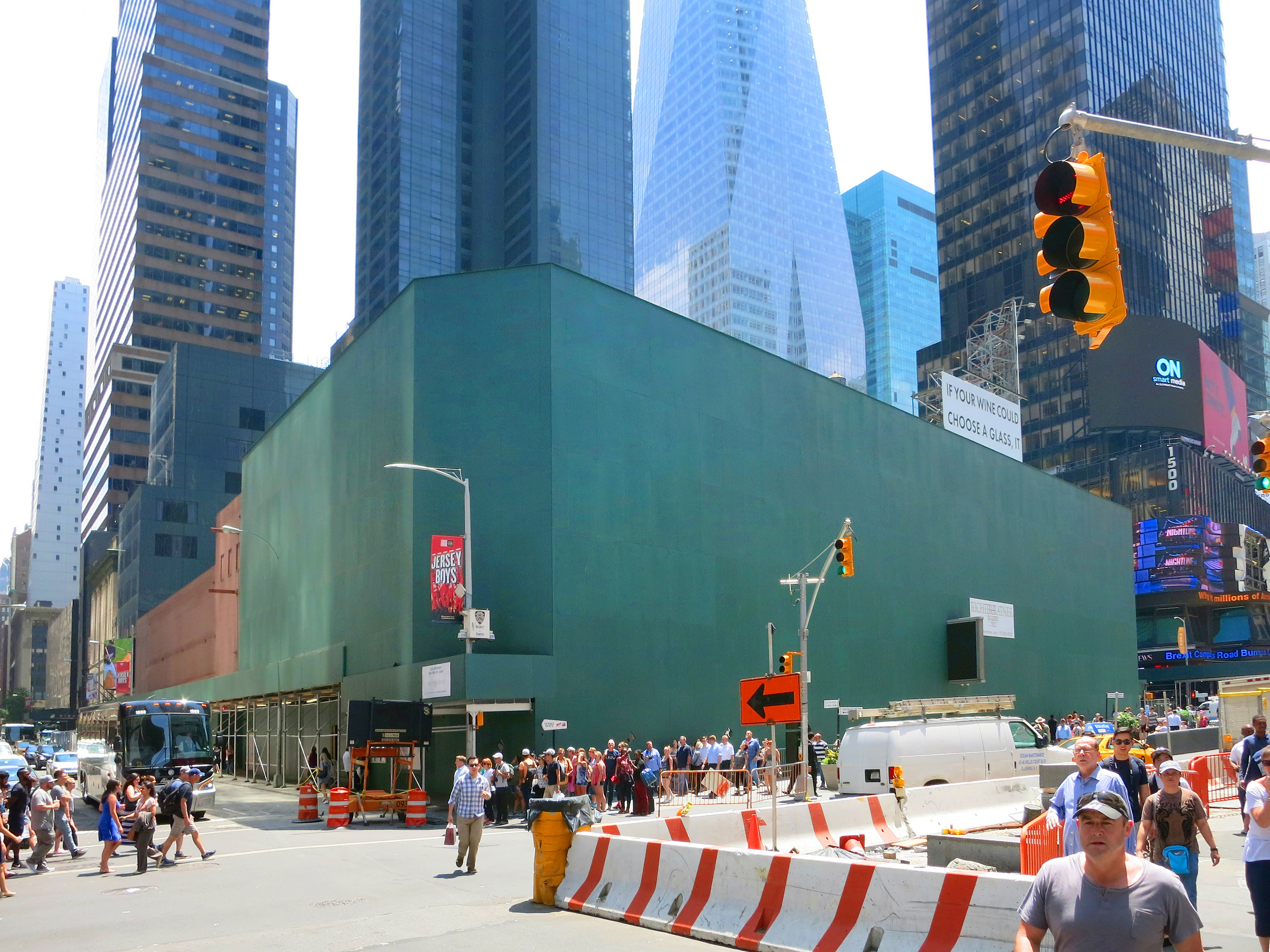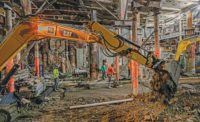Compared with some of its Manhattan neighbors, a high-rise on the corner of Seventh Avenue and West 47th Street looks standard. Like many buildings in Times Square, the 41-story retail-entertainment-hotel development, nearly topped out, has a tower springing from a boxy base that will sport a flashy billboard.
Though the $1-billion development, called 20 Times Square, involved mining 30,000 cu yd of bedrock, 20 TS’s excavation was not as nerve-racking—or claustrophobic—as carving a concert “cave” under the landmarked Carnegie Hall, 10 blocks north. That project, which finished a year late in December 2002, was dubbed Carnegie Hell (ENR 7/16/01 p. 30).
Twenty TS does have long-span trusses, but their erection was not as heroic as temporarily cantilevering a 130-ft-long bridge over a landmark theater to support a hotel tower. Crews did that directly across West 47th Street in the late 1980s (ENR 11/16/89 p. 28).
And though it also involved shoring a bay-wide steel frame, 20 TS was not as wobbly during construction as the 50-story Marriott Marquis, across Broadway and built in the 1980s (ENR 2/23/84 p. 26).
Not as nerve-racking, heroic or ambitious as its Manhattan neighbors, 20 TS is still no open-and-shut case. Most of the job’s trials stem from the developer’s brainstorm to build a larger billboard—and generate more revenue—by filing the project as an alteration of the existing theater on the site.
Zoning for new construction allows for a 60-ft-tall street wall before a setback. Rules for alterations say the street wall can retain the same height as the original—in this case, 125 ft.
One way for the development to qualify as an alteration was to keep at least 25% of the original floor area. Ultimately deciding on this course, Witkoff-Maefield Development retained the steel frame of an 89-ft-tall perimeter bay that, in plan, is an L-shape, with a 100-ft leg along Seventh Avenue and a 150-ft leg along West 47th Street.
The developer’s decision resulted in enough space to hang an 18,000-sq-ft wraparound sign, but it opened up a can of worms. Three years ago, when crews started stripping the L’s frame, they found misplaced columns, skewed beams and deteriorated floor slabs.
That threw a wrench in the works. “It was back to the drawing board” for the L’s shoring scheme, needed until permanent steel could be laced in, says Kenneth M. Colao, president of CNY Group, which has a $211-million guaranteed-maximum-price contract for the project’s core and shell.
The unanticipated conditions delayed filings to the authorities with jurisdiction, including both the site logistics and safety plans as well as the comprehensive engineering submittals, says Colao. For example, it took five extra months to get the old theater’s structural demolition permit.
To make up the time, CNY eventually went to three work shifts. The acceleration cost was less than the $170,000-per-day carrying costs, says Colao. Completion is expected before April 2018, as originally planned, he adds.
The alteration woes were piled onto the usual challenges of construction in one of the world’s most congested districts and alongside a subway station.
CNY had to maintain a sidewalk for the approximately 400,000 passersby each busy day. For that, crews had to move the protective shed a half-dozen times into the street and back.
The team was on constant alert for onlookers who would get too close to the work for comfort.
Colao calls the project his “most taxing, yet exhilarating,” in his 37 years in construction. “The risks are huge,” he says.
The site is hemmed in, leaving little laydown area. Just-in-time deliveries are at night. Street closings are allowed only for major picks, including the job’s two 60-ton girders. “There were so many moving parts. It was very tricky,” says Dennis J. Prude, CNY’s executive vice president of field operations.
The building, designed by Platt Byard Dovell White Architects LP, consists of a 35-story hotel tower that has a cast-in-place concrete flat-plate structure, with shear walls and columns. The six-story podium is largely free of interior columns. All elevator core steel in the podium is encased in concrete. Twenty TS has three basements, which is two more than the old theater.
A two-story mechanical level at the top of the podium contains the systems that transfer loads from the tower to the podium. This configuration includes 35 plate girders, as deep as 10 ft and as heavy as 60 tons, which transfer loads to structural-steel superframes, with diagonal members, on Seventh Avenue and West 47th Street elevations. The girders also transfer loads to a superframe encased in concrete within the north wall and, on the east side, to a concrete shear wall with embedded steel members.
The hotel core’s vertical load is transferred to two parallel trusses, weighing 1,200 lb per linear ft, that deliver loads to four perimeter supercolumns and to the foundation.
Lateral loads from the hotel core go though mechanical-floor diaphragms to the superframes on Seventh Avenue and West 47th Street and to the foundation.
“One needs a complex road map to follow the load path” from the tower’s many columns to the podium’s few columns, says Cawsie Jijina, a principal of project structural engineer Severud Associates Consulting Engineers PC.
There was no documentation for the old theater’s structure; however, after soft demolition, an initial 3D laser scan of the L offered some glimpses. Severud engineered the new L-structure, which was required to support additional loads, around the existing steel.
“We knew before we touched the theater, we had to figure out how to stabilize the L,” says Colao.
CNY ruled out shoring outside the L because of proximity to the adjacent subway platforms and interference with the rest of the work inside the site. That left shoring within the L. The original plan had been to stabilize each column line and bring loads to closely spaced temporary piles and pile caps.
After soft demolition, the plan changed to four 80-ft-deep caisson clusters with elevated caisson caps, positioned every three bays to provide needed clearance for equipment. A grillage system spanned between caps and supported Pratt trusses, which picked up the L’s temporary braced frames, columns and header beams.
CNY scheduled demolition of the 1904 theater in phases, beginning in February 2014 and ending in June 2015. Workers razed the old theater from the top down and then removed its core, leaving only the L.
Once the city issued the permit for the theater’s structural demolition, crews removed the L’s concrete encasement. The laser scan was updated, uploaded to the building information model and shared with the design team.
For three months, beginning in summer 2014, demo crews stripped the L during the day shift. Working from the top down, erector A.J. McNulty & Co. Inc. eventually installed a total of 240 tons of temporary steel, typically working from 3 p.m. until midnight.
The original plan was to start at the base, but several factors, including an unsupported brick wall, forced the switch, says Michael T. Cooke, executive vice president for the temporary-steel contractor, Owen Steel Co. Inc.
“Typically, we have complete design drawings, detail every piece, and we rock ’n’ roll,” says Cooke. “For this job, until an area was demolished, we didn’t know what we were getting into. It was a hunt-and-peck situation,” with additional shoring added as needed, he notes.
There was no hoist or crane. Crews used pulleys, a trolley system or literally manhandled the steel pieces into place. Work, which started in August 2014 and finished in April 2015, took twice as long as originally anticipated, says Cooke.
“We had to be out there, bobbing and weaving, redrawing on site, with some field fabrication, as well,” says Cooke. Owen met with a rep from Howard I. Shapiro & Associates Consulting Engineers PC, hired by the owner to oversee the shoring work, on a daily basis to resolve field issues.
Work on the temporary caissons began in November 2014. Rock was harder than expected, with up to 80 tons of compressive strength. Some equipment even got stuck.
“Our first excavation contractor got intimidated and wanted to add time to the schedule,” says CNY’s Colao. “We changed to Civetta Cousins, which also had blasting capability, just in case.”
The existing grade slab had to be removed in places to fit the drill rig in the basement. “Given the intricacy of the temporary structure overhead and the location of the caissons, it became a mining operation,” says Colao.
Surprises
In the L, crews from erector J.F. Stearns had to snake in the new steel under and around both the existing frame, which was out of whack, and the temporary steel. Crews had to jam in short pieces between floors. Every step of the process required intense coordination of all the parties involved, says Severud’s Jijina.
To lower the crane hook into the L, crews fabricated custom 150-ft-long rigging. At times, Stearns had to re-rig steel at different pick points to maneuver around the existing structure. Some members required three to four picks to set.
“Even as we started, they would demo out concrete floors and find surprises,” says David Roberts, vice president of projects for steel contractor Banker Steel.
Throughout, the work-obstructing temporary steel had to be modified. “Even with the BIM interface, the clash detection was not perfect,” says Roberts. “The erector still had to build the job off the 2D drawings.”
In the original plan, the L’s old concrete decks were in place. “We had no floor to work off” because the old decks were not viable and had been removed, says Roberts.
Last summer, once the load was transferred to the permanent steel, CNY was released for removal of temporary steel in “carefully sequenced phases from the top down,” says Colao. Crews took out the last caisson in October.
In June 2015, after the L was supported by the grillage and temporary Pratt trusses, crews started foundation excavation, underpinning and tieback installation along the Seventh Avenue subway station. The work wrapped up a year ago.
All the time, instruments monitored the L to make sure movement was less than a quarter inch in any direction. “We were constantly on guard,” says CNY’s Prude.
The new building area’s tower crane, anchored to the lowest basement level, went in a year ago as workers completed foundations. Permanent-steel erection, originally set to begin in May 2015, started last February.
The concrete contractor also used the steel crane to encase the steel core columns in concrete. Steel erection took place mostly during the day and other work at night. “We couldn’t have steel work going on over the heads of any of the other workers,” says Prude.
Picking steel for the new areas of the building was not easy, either. “We had to reach over the L to set every piece,” says Roberts.
Before its dismantling last July, the steel tower crane, anchored in the basement, helped to install a concrete tower crane, anchored to grillage near the top of the podium. “We needed a crane for lighter loads that worked at double the speed,” says Kevin Smith, senior project manager for superstructure concrete at Navillus Contracting.
Smith expects concrete work to be substantially complete in a few weeks. During the L delay, “we had to mobilize and demobilize two or three times,” says Smith. “It’s nice to be out of the weeds.”












Post a comment to this article
Report Abusive Comment